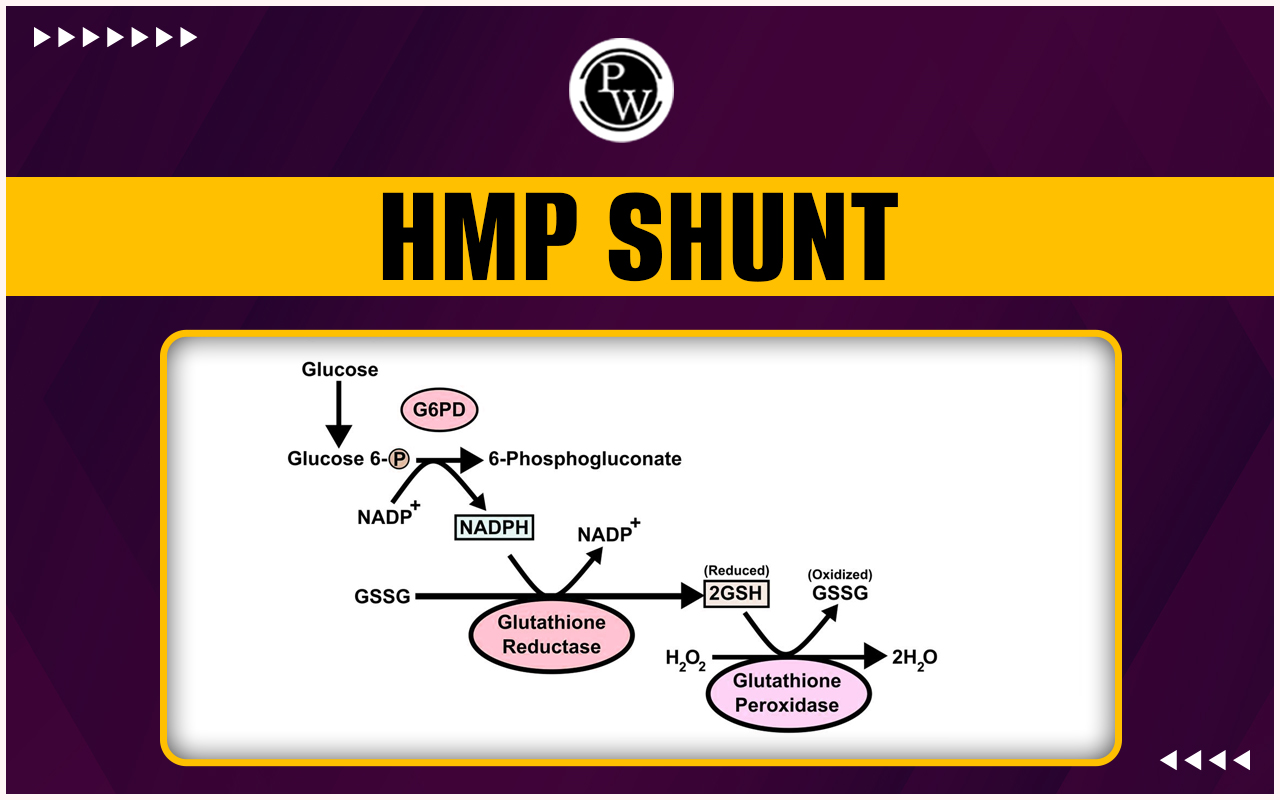

HMP Shunt Pathway: The hexose monophosphate (HMP) shunt, also called the pentose phosphate pathway or the phosphogluconate pathway, is a metabolic process that occurs alongside glycolysis. This pathway generates NADPH and produces intermediates needed for the synthesis of nucleic acids and amino acids. Below are the NEET Biology notes on the HMP shunt pathway.
HMP Shunt Pathway
The Hexose Monophosphate Shunt, also known as the Pentose Phosphate Pathway (PPP) or the Phosphogluconate Pathway, is an alternative pathway for glucose oxidation that occurs in the cytosol. Unlike catabolic pathways, its primary function is anabolic. This pathway is important for the biosynthesis of NADPH and pentoses. It is most active in steroid-producing tissues, red blood cells, and the liver. The Pentose Phosphate Pathway is divided into two phases:- Oxidative Phase: In this phase, each molecule of glucose-6-phosphate is oxidized to ribulose-5-phosphate, producing NADPH and releasing CO2.
- Non-Oxidative Phase: This phase involves the interconversion of 3, 4, 5, and 7-carbon sugars, leading to the synthesis of pentose-phosphate and other phosphate monosaccharides.
Sexual Reproduction in Flowering Plants
HMP Shunt Pathway Occurs in
The HMP shunt pathway, also known as the pentose phosphate pathway, takes place in the cytoplasm of most organisms. However, in plants, it occurs in plastids. This pathway is an important metabolic process that works alongside glycolysis. It produces key molecules for the body, including:- NADPH: A reducing agent used in various biosynthesis reactions in the cell.
- Ribose-5-phosphate: A precursor for the synthesis of nucleotides, which are the building blocks of DNA and RNA.
- Erythrose-4-phosphate: An intermediate used in the synthesis of aromatic amino acids.
- Liver
- Red blood cells
- Adrenal cortex
- Mammary glands
- Testes
- Adipose tissue
HMP Shunt Pathway Steps
The hexose monophosphate (HMP) shunt, also known as the pentose phosphate pathway, is an alternative to glycolysis that occurs in the cytoplasm of cells. It serves two primary functions:- Produces NADPH: This reducing equivalent is essential for biosynthetic processes such as the synthesis of fatty acids, steroids, and the regeneration of glutathione.
- Generates ribose-5-phosphate for nucleotide synthesis: This compound is essential for building RNA and DNA.
Oxidative Phase
- Glucose-6-phosphate dehydrogenase (G6PD) catalyzes the oxidation of glucose-6-phosphate to 6-phosphogluconate delta-lactone, producing one molecule of NADPH.
- 6-phosphogluconate delta-lactone is hydrolyzed by 6-phosphogluconolactonase to form 6-phosphogluconate.
- 6-phosphogluconate dehydrogenase catalyzes the decarboxylation of 6-phosphogluconate to ribulose-5-phosphate, generating another molecule of NADPH.
- Ribulose-5-phosphate can be isomerized to ribose-5-phosphate by ribulose-5-phosphate epimerase.
| NEET Biology Notes | |||
|---|---|---|---|
| Embryo | Funaria | Selaginella | Malvaceae |
| Polyembryony | Apomixis | Pinus | Pollen Grains |
| Chara | Volvox | Endosperm | Equisetum |
Non-oxidative Phase
This phase consists of reversible reactions that convert ribulose-5-phosphate and other pentose phosphates into intermediates of glycolysis or the pentose phosphate pathway, depending on the cell's needs. Importantly, the non-oxidative phase does not produce NADPH. A simplified summary of the HMP shunt pathway steps: Glucose-6-phosphate ➡️ 6-phosphogluconate delta-lactone ➡️ 6-phosphogluconate ➡️ ribulose-5-phosphate (oxidative phase) Ribulose-5-phosphate (can be isomerized to ribose-5-phosphate) ➡️ other pentose phosphates ➡️ glycolytic intermediates (non-oxidative phase)Regulation of HMP Shunt Pathway
The hexose monophosphate (HMP) shunt, also known as the pentose phosphate pathway, is a carefully regulated metabolic process that works alongside glycolysis. Unlike glycolysis, which is primarily concerned with generating ATP, the HMP shunt focuses on producing two essential molecules: Ribose-5-phosphate (R5P): This molecule is a precursor for the synthesis of nucleotides, the building blocks of RNA and DNA. NADPH: This molecule acts as a reducing agent and is vital for various biosynthetic reactions, including fatty acid synthesis and the antioxidant defense system that protects cells from damage caused by free radicals. The regulation of the HMP shunt ensures that the cell produces the right amount of R5P and NADPH according to its needs. The main regulatory mechanisms include: 1. Enzyme Activity: Glucose-6-phosphate dehydrogenase (G6PD): This is the rate-limiting enzyme of the HMP shunt, and its activity is primarily controlled by the levels of NADP+ and NADPH in the cell.- High NADP+ levels: Activate G6PD, thereby promoting the HMP shunt when the cell requires more R5P or NADPH.
- High NADPH levels: Inhibit G6PD, slowing down the pathway when there is enough NADPH.
- Increased glucose intake or breakdown of glycogen stores: Leads to higher levels of glucose-6-phosphate, which can stimulate the pathway.
- Insulin: Promotes G6PD activity, potentially increasing the pathway's activity during fed states.
- Glucagon: Opposes the effects of insulin and may decrease HMP shunt activity during fasting.
- Thyroid hormones: Can stimulate G6PD activity.
| NEET Biology Notes | ||
|---|---|---|
| Plasma Membrane Structure | Pre-Fertilisation | Economic Importance of Algae |
| Slime moulds | hypotonic solution | Post fertilisation |
Significance of HMP Shunt Pathway
The Hexose Monophosphate (HMP) shunt is essential for several reasons:- Nucleic Acid Synthesis: The non-oxidative phase of the HMP shunt produces ribose-5-phosphate, a key precursor for RNA and DNA synthesis. This pathway is particularly active in rapidly dividing cells that need a steady supply of nucleotides for growth and replication.
- NADPH Production for Biosynthesis: The oxidative phase of the HMP shunt generates NADPH, which is crucial for various anabolic reactions. NADPH is vital for the synthesis of fatty acids and cholesterol, important components of cell membranes and steroid hormones.
- Cellular Redox Balance: NADPH is also important for maintaining cellular redox balance. It helps regenerate glutathione, an antioxidant that protects cells from oxidative damage. This is especially important for red blood cells, which are constantly exposed to reactive oxygen species.
- Pentose Sugar Metabolism: The HMP shunt provides pentose sugars that serve as precursors for nucleotides and play roles in other cellular processes, such as amino acid metabolism.
| NEET Biology Notes | |||
|---|---|---|---|
| Rhizopus | Fibrous root | Marchantia | Actinomycetes |
| Nostoc | Spirogyra |
Ribosomes | Liverworts |
Clinical Significance:
Problems with the HMP shunt pathway can lead to various health issues. Deficiencies in specific enzymes of this pathway can cause:- Favism: This condition leads to hemolytic anemia (destruction of red blood cells) when exposed to fava beans.
- Non-spherocytic Hemolytic Anemia: A rare blood disorder characterized by the breakdown of red blood cells due to impaired antioxidant defenses.
- Glucose-6-Phosphate Dehydrogenase Deficiency: The most common enzyme deficiency related to the HMP shunt, causing various complications depending on its severity.
| NEET Exam Important Links | |
|---|---|
| NEET Syllabus | NEET Biology Diagrams |
| NEET Biology MCQ | NEET Biology Chapter wise Weightage |
| NEET Biology Notes | NEET Previous Year Question papers |
HMP Shunt Pathway FAQs
Q 1. Why is the HMP important?
Ans. The HMP (hexose monophosphate) pathway is crucial because it helps synthesize steroids and fatty acids. It also plays a significant role in the immune system by functioning within phagolysosomes.
Q 2. What is the HMP shunt for?
Ans. The HMP shunt, or the pentose phosphate pathway, is a special pathway that generates essential compounds for the body. It is an alternative to glycolysis and produces ribose-5-phosphate and NADPH, which are vital for various cellular functions.
Q 3. What is the role of the HMP shunt in RBCs?
Ans. In red blood cells, the enzyme G6PD (glucose-6-phosphate dehydrogenase) in the HMP shunt pathway converts glucose-6-phosphate into 6-phosphogluconate while reducing NADP to NADPH. This process leads to the production of glutathione, a critical antioxidant for red blood cells.
Q 4. Why is no ATP formed in the HMP shunt?
Ans. The HMP pathway does not use ATP and only produces one mole of ATP when forming pyruvate. However, it does produce reduced pyridine nucleotides, which can act as hydrogen donors in the reduction of organic compounds.
Q 5. What are the two important byproducts of the HMP shunt?
Ans. The HMP shunt occurs in the cytosol and produces NADPH and pentoses like ribose-5-phosphate. These byproducts are important for the synthesis of lipids, steroids, and nucleic acids.
Talk to a counsellorHave doubts? Our support team will be happy to assist you!

Check out these Related Articles
Free Learning Resources
PW Books
Notes (Class 10-12)
PW Study Materials
Notes (Class 6-9)
Ncert Solutions
Govt Exams
Class 6th to 12th Online Courses
Govt Job Exams Courses
UPSC Coaching
Defence Exam Coaching
Gate Exam Coaching
Other Exams
Know about Physics Wallah
Physics Wallah is an Indian edtech platform that provides accessible & comprehensive learning experiences to students from Class 6th to postgraduate level. We also provide extensive NCERT solutions, sample paper, NEET, JEE Mains, BITSAT previous year papers & more such resources to students. Physics Wallah also caters to over 3.5 million registered students and over 78 lakh+ Youtube subscribers with 4.8 rating on its app.
We Stand Out because
We provide students with intensive courses with India’s qualified & experienced faculties & mentors. PW strives to make the learning experience comprehensive and accessible for students of all sections of society. We believe in empowering every single student who couldn't dream of a good career in engineering and medical field earlier.
Our Key Focus Areas
Physics Wallah's main focus is to make the learning experience as economical as possible for all students. With our affordable courses like Lakshya, Udaan and Arjuna and many others, we have been able to provide a platform for lakhs of aspirants. From providing Chemistry, Maths, Physics formula to giving e-books of eminent authors like RD Sharma, RS Aggarwal and Lakhmir Singh, PW focuses on every single student's need for preparation.
What Makes Us Different
Physics Wallah strives to develop a comprehensive pedagogical structure for students, where they get a state-of-the-art learning experience with study material and resources. Apart from catering students preparing for JEE Mains and NEET, PW also provides study material for each state board like Uttar Pradesh, Bihar, and others
Copyright © 2025 Physicswallah Limited All rights reserved.
Get App











